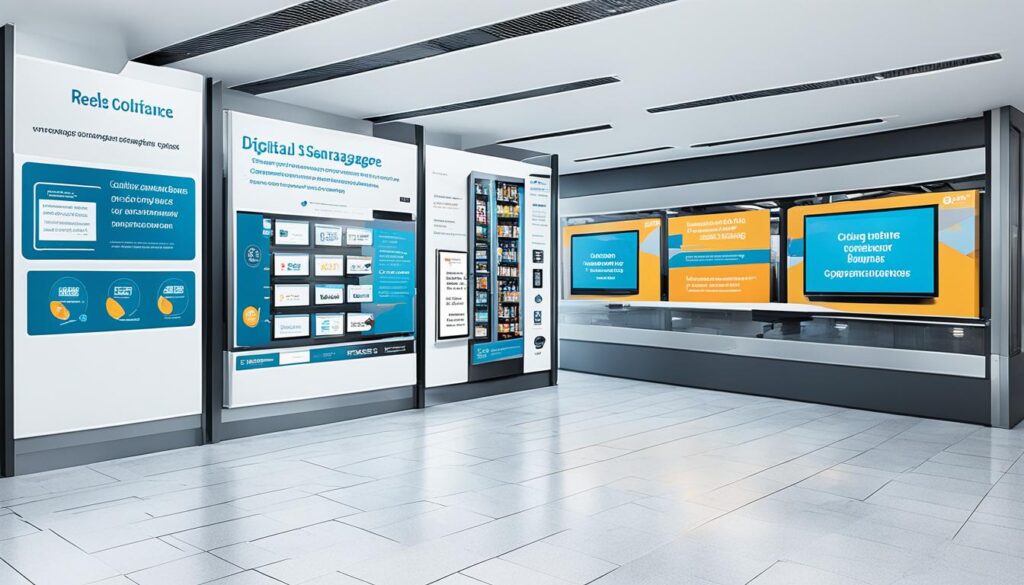Welcome to our comprehensive guide on the advantages and disadvantages of digital signage. In today’s digital age, businesses are constantly looking for innovative ways to engage their audience and enhance their brand presence. Digital signage has emerged as a popular solution, offering an array of benefits that can elevate your marketing strategy. However, like any technology, it also has its downsides that you need to consider before investing.
Let’s explore the pros and cons of digital signage to help you make an informed decision for your business.

Key Takeaways:
- Digital signage offers increased brand recognition and improved customer experience.
- It enables you to display dynamic and engaging content that grabs attention.
- Real-time updates allow for timely promotions and time-sensitive information.
- Valuable analytics data can be gathered to optimize your digital signage campaigns.
- However, digital signage comes with initial cost, technical challenges, security risks, content management requirements, and limited reach.
Dynamic and Engaging Content
Digital signage allows businesses to create a dynamic and captivating visual experience for their audience. By incorporating animations and videos into their displays, businesses can grab and hold the viewer’s attention, making it more engaging than traditional static signage.
“Digital signage enables us to showcase our products in a way that truly captivates our customers. The use of dynamic content, such as animated product demos and videos highlighting our brand story, has significantly increased customer engagement and interest.”
With the ability to display dynamic content, businesses can create eye-catching visuals that convey information and tell stories in a more compelling manner. Whether it’s showcasing new products, promoting special offers, or sharing customer testimonials, dynamic content can effectively communicate the intended message and leave a lasting impression on viewers.
Moreover, the interactive nature of digital signage allows businesses to tailor their content based on real-time data and customer preferences. By analyzing customer behavior and feedback, businesses can continuously optimize their content strategy, ensuring that the displayed information remains relevant and impactful.
By leveraging the power of dynamic and engaging content, businesses can elevate their brand presence and establish a deeper connection with their target audience. Whether it’s through eye-catching animations, informative videos, or visually appealing slideshows, digital signage enables businesses to deliver content that stands out and leaves a lasting impression.
| Benefits of Dynamic and Engaging Content | Traditional Static Signage | Digital Signage |
|---|---|---|
| Captivates audience attention | Limited to static images or text | Can incorporate animations, videos, and dynamic elements |
| Enhances brand storytelling | Relies on short, static messages | Enables immersive storytelling through videos and multimedia content |
| Increases customer engagement | Passive viewing experience | Interactive elements encourage active engagement |
| Delivers real-time and dynamic information | Requires manual updates | Can display real-time data and dynamically change content |
Real-Time Updates
One of the key advantages of digital signage is its ability to provide real-time updates. With traditional static signage, making changes to the content can be time-consuming and costly. However, digital signage allows for quick and easy updates, ensuring that the information displayed is always current and relevant.
Real-time updates are particularly beneficial for displaying time-sensitive information, such as upcoming events, sales, or promotions. Businesses can easily make changes to their signage to reflect any last-minute updates or changes in schedules, ensuring that customers are informed and up-to-date.
Furthermore, real-time updates enable businesses to effectively promote time-limited offers or promotions. By quickly updating the content on digital signage screens, businesses can create a sense of urgency and encourage customers to take immediate action. Whether it’s a limited-time discount or a flash sale, real-time updates make it easier than ever to capture customers’ attention and drive sales.
Here’s an example of how real-time updates can be used to promote time-sensitive information:
“Hurry! Today only – 50% off all products. Visit our store now for incredible savings!”
By displaying such promotions on digital signage screens, businesses can attract customers and entice them to take advantage of limited-time offers.
Real-time Updates in Action
To better understand the impact of real-time updates, take a look at the following table, which compares the effectiveness of traditional static signage versus digital signage with real-time updates:
| Signage Type | Updates | Effectiveness |
|---|---|---|
| Traditional Static Signage | Manual process, time-consuming | Limited impact, outdated information |
| Digital Signage with Real-Time Updates | Quick and easy, real-time changes | Highly effective, current and relevant information |
As you can see, digital signage with real-time updates offers a significant advantage over traditional static signage. It allows businesses to stay agile and adapt their messaging in real-time, ensuring that the content displayed is always up to date, engaging, and impactful.

Increased Brand Awareness
Digital signage is an effective tool for increasing brand awareness. By displaying branded content and messaging in a visually appealing way, businesses can capture the attention of their target audience and leave a lasting impression. The dynamic nature of digital signage allows for creative and engaging storytelling, making it easier to connect with customers on a deeper level.
Branded content on digital signage can include images, videos, animations, and interactive elements that showcase the unique personality and values of the brand. This consistent messaging across multiple locations helps to reinforce brand recognition and build a strong brand identity.
Here’s an example of how digital signage can be used to increase brand awareness:
“We installed digital signage screens in our retail stores, and the impact on our brand awareness has been remarkable. The visually appealing content we display on the screens has caught the attention of both our loyal customers and new visitors. We’ve seen an increase in foot traffic and an overall positive perception of our brand. The consistent messaging across all our locations has also helped to reinforce our brand recognition. We’re thrilled with the results!”- Sarah Thompson, Marketing Director at XYZ Retail
In addition to capturing attention and building recognition, digital signage allows businesses to deliver consistent messaging across different touchpoints. This means that whether customers interact with the brand through physical stores, websites, or social media, they receive a cohesive message that reinforces brand values and key marketing messages.
Overall, digital signage plays a crucial role in increasing brand awareness by showcasing branded content, strengthening brand recognition, and delivering consistent messaging across multiple locations.
Improved Customer Experience
One of the key advantages of digital signage is its ability to greatly improve the customer experience. By providing helpful information and enhancing the overall journey, businesses can create a more positive and engaging environment for their customers.
Digital signage plays a crucial role in wayfinding, ensuring that customers can easily navigate through large or complex spaces. Whether it’s guiding visitors to different sections in a retail store or helping guests find their way in a busy hospital, digital signage offers clear and concise directions that reduce confusion and save time.
Additionally, digital signage offers valuable product information that customers can access at a glance. It allows businesses to showcase key features and benefits, pricing details, and even real-time inventory updates, enabling customers to make informed purchase decisions quickly and easily.
Another way digital signage improves the customer experience is by reducing perceived wait times. With the ability to display engaging content, such as entertaining videos or informative slideshows, businesses can effectively distract and engage customers while they wait, making the experience more enjoyable and memorable.
| Benefits of Improved Customer Experience |
|---|
| Enhanced customer satisfaction |
| Increased brand loyalty |
| Improved customer retention |
| Positive word-of-mouth referrals |
This improved customer experience ultimately leads to a range of positive outcomes for businesses. Enhanced customer satisfaction and increased brand loyalty can create long-term relationships and drive repeat business. Additionally, improved customer retention and positive word-of-mouth referrals can contribute to sustainable growth and success.

Overall, digital signage is a powerful tool for businesses looking to provide helpful information, streamline the customer journey, and reduce waiting times. By leveraging the benefits of digital signage, businesses can create a more seamless and enjoyable experience for their customers.
Analytics
Valuable analytics data is a crucial component of digital signage campaigns, allowing businesses to measure the success and impact of their signage efforts. By tracking impressions and engagement rates, businesses can gather valuable insights to optimize content and improve the effectiveness of their digital signage campaigns.
Impressions provide a measure of the number of times a digital signage display is seen by viewers. This data helps businesses understand the reach and visibility of their content. By analyzing the impressions data, businesses can make informed decisions about the placement and positioning of their signage to maximize its exposure.
Engagement rates, on the other hand, measure the level of interaction and attention generated by the digital signage. This data includes actions such as touch screen interactions, clicks, and dwell time. By understanding the engagement rates, businesses can gauge the effectiveness of their content in capturing and holding the viewer’s attention.
With the valuable analytics data obtained from digital signage campaigns, businesses can optimize their content based on real-time insights. By analyzing the impressions and engagement rates, businesses can refine their messaging, visuals, and calls-to-action to better resonate with their target audience. This data-driven approach allows businesses to continuously improve their digital signage campaigns and achieve better results.
“Analytics data from digital signage campaigns provides valuable insights that can drive informed decision-making and optimize content for maximum impact.”
By leveraging analytics data, businesses can gain a deeper understanding of their audience’s preferences, behaviors, and interests. This knowledge can inform content creation and strategy, ensuring that digital signage campaigns are aligned with the needs and expectations of the target audience.
Ultimately, valuable analytics data empowers businesses to make data-driven decisions, refine their content, and drive better results from their digital signage campaigns.
| Benefits of Analytics in Digital Signage Campaigns | How it Helps |
|---|---|
| Measure impressions | Understand reach and visibility of content |
| Track engagement rates | Gauge effectiveness in capturing viewer attention |
| Optimize content based on insights | Refine messaging, visuals, and calls-to-action |
| Understand audience preferences | Create content aligned with target audience |
By harnessing the power of analytics, businesses can unlock the full potential of their digital signage campaigns and drive meaningful results.
Initial Cost
While digital signage offers a range of benefits for businesses, one potential drawback is the initial cost associated with implementing this technology. The investment in hardware and software can be significant, which may pose a barrier for small businesses with limited financial resources.
Let’s take a closer look at the components that contribute to the initial cost of digital signage:
| Hardware | Software |
|---|---|
| Displays | Digital signage software |
| Media players | Content management system |
| Mounting brackets | Data integration tools |
| Connectivity devices | Analytics and reporting features |
This hardware and software infrastructure forms the foundation for an effective digital signage network. However, it’s important to note that the specific requirements and costs can vary depending on the scale and complexity of the deployment.

Despite the initial cost, it’s essential for businesses to consider the long-term benefits that digital signage can bring, such as increased brand awareness, improved customer experience, and valuable analytics data. Moreover, there are strategies and options available to help mitigate the initial cost and make digital signage more accessible to small businesses.
Technical Issues
While digital signage offers numerous benefits, it is not without its potential challenges. One of the common issues that businesses may encounter is technical problems that can disrupt the display of content. These technical issues can range from hardware malfunctions to software glitches, causing inconvenience and hindering the effectiveness of digital signage.
Hardware malfunctions can occur due to various reasons, such as faulty equipment, power outages, or connectivity problems. These issues can interrupt the smooth operation of digital signage displays and require prompt troubleshooting and maintenance to restore functionality.
Software glitches, on the other hand, can stem from programming errors, compatibility issues, or even software updates. Such glitches may result in unexpected behavior or malfunctioning of the digital signage system, leading to content display inconsistencies or complete display failures.
Dealing with technical issues in digital signage requires a proactive approach. Regular maintenance, timely software updates, and diligent hardware checks can help minimize these problems. Additionally, having a responsive technical support team can ensure quick resolution and minimize downtime.
“We understand that technical issues can arise in digital signage systems, and our team is always ready to provide prompt support to address any disruptions. With our expertise and commitment to customer satisfaction, we aim to keep your digital signage displays running smoothly.”
Image illustrating a hardware malfunction
In the next section, we will explore another potential drawback of digital signage – security risks – and discuss ways to mitigate them.
Security Risks
When it comes to digital signage, security risks are a crucial concern that businesses need to address. Hacking and unauthorized access pose significant threats to the integrity and safety of the content displayed on digital signage systems. These security vulnerabilities can lead to the compromise of sensitive information, unauthorized content modifications, or even the complete shutdown of digital signage networks.
Protecting against security risks is essential to maintain the trust of customers and ensure the smooth operation of digital signage campaigns. Implementing robust security measures and following best practices can help mitigate these risks and safeguard the content displayed on digital signage platforms.
“Security breaches in digital signage can have severe consequences, ranging from tarnishing the brand’s reputation to financial losses. It is crucial for businesses to prioritize security and establish a proactive approach to address potential vulnerabilities.”
One effective way to enhance security is by adopting encryption protocols to protect data transmission between the digital signage player and the server. Additionally, employing strong passwords and regular updates for software and firmware can bolster the security of digital signage systems. Regular security audits and penetration testing are also recommended to identify and rectify any potential vulnerabilities.
Furthermore, raising awareness among employees about security risks and implementing access control measures can help prevent unauthorized access to digital signage systems. Establishing clear guidelines for content creation, approval, and publishing can minimize the risk of compromised content being displayed.
By taking a proactive approach to security, businesses can better protect their digital signage investments and ensure the uninterrupted delivery of engaging and impactful content to their target audience.

Benefits of Addressing Security Risks:
- Protects sensitive information from unauthorized access
- Preserves brand reputation and customer trust
- Reduces the risk of content tampering or malicious activities
- Ensures the uninterrupted operation of digital signage networks
Implementing robust security measures is crucial for businesses leveraging digital signage to mitigate security risks effectively.
| Security Risks | Potential Impact |
|---|---|
| Hacking | Compromise of sensitive information and unauthorized access to the digital signage network |
| Unauthorized Access | Modification or deletion of content, potential disruption of digital signage campaigns |
| Compromise of Integrity and Safety of Content | Tarnished brand reputation, loss of customer trust, and financial implications |
Content Management
Managing content for digital signage can be a time-consuming and resource-intensive task, especially for businesses with multiple locations. With the need to constantly update and refresh content across various screens, it requires careful planning and coordination to ensure a seamless and engaging experience for your audience.
Content management involves creating, organizing, scheduling, and monitoring the content displayed on digital signage screens. It includes tasks such as:
- Developing compelling and informative content that aligns with your brand and objectives.
- Ensuring consistency in messaging and visual design across all locations.
- Updating content in real-time to reflect changes in promotions, events, or other time-sensitive information.
- Syncing content across multiple screens and locations to maintain a cohesive brand presence.
- Monitoring the performance and effectiveness of your content through analytics and metrics.
Effective content management is crucial for delivering relevant and impactful messages to your target audience. It allows you to create personalized experiences, deliver timely information, and maximize the potential of digital signage.
“Content management for digital signage requires careful coordination to ensure a seamless and engaging experience.”
Implementing a content management system (CMS) can streamline the process and make it more efficient. A CMS provides a centralized platform where you can easily create, edit, schedule, and distribute content across your digital signage network. It enables you to control and manage content remotely, saving time and resources while ensuring consistency and quality.
With the right content management strategy in place, businesses can overcome the challenges associated with content creation and distribution, effectively leveraging the power of digital signage to engage and inform their audience.
Limited Reach
Digital signage is a powerful tool for businesses to communicate their message and engage with their audience. However, one limitation of digital signage is its limited reach, as it is confined to physical locations. This can pose challenges for businesses that rely heavily on online or mobile channels to reach their target audience.
Unlike online platforms or mobile apps that can be accessed from anywhere with an internet connection, digital signage is only visible to those present in the vicinity of its physical location. This means that businesses may miss out on reaching a wider audience that is not physically present at the location where the digital signage is installed.
Furthermore, while digital signage can attract attention and provide valuable information to those who pass by the physical location, it may not have the same level of impact as online or mobile channels that have a broader reach and can reach a larger number of people simultaneously.
Targeting a Local Audience
Despite its limited reach, digital signage can still be effective for businesses that have a specific target audience within a certain geographical area. For example, a local restaurant can use digital signage to display daily specials or promote upcoming events to attract customers who are in the vicinity of the establishment.
By strategically placing digital signage in high-traffic areas or locations where the target audience is likely to be present, businesses can maximize the visibility and impact of their message. This can be particularly beneficial for businesses that primarily cater to a local clientele or have physical storefronts.
| Pros | Cons |
|---|---|
| Targeted messaging to a local audience | Limited reach beyond physical location |
| Opportunity to capture the attention of passersby | May not reach online or mobile-oriented audience |
| Enhanced visibility in a specific area | Restrictions on audience size and potential for growth |
Although digital signage has its limitations in terms of reach, businesses can leverage other marketing channels, such as social media or mobile advertising, to complement their digital signage efforts and expand their audience reach. By integrating digital signage with online and mobile strategies, businesses can create a cohesive and comprehensive marketing approach that targets both the physical and virtual realms.
Ultimately, the decision to invest in digital signage should be based on the specific goals and target audience of the business. While it may not be suitable for every business or marketing objective, digital signage can still be a valuable tool for engaging with a local audience and reinforcing the brand presence within physical locations.
Conclusion
Digital signage offers businesses a wide range of benefits that can significantly impact their marketing and customer engagement strategies. With dynamic and engaging content, businesses can capture the attention of their target audience, leaving a lasting impression.
Real-time updates allow for the seamless display of time-sensitive information and promotions, ensuring that customers are always kept informed and engaged. The increased brand awareness achieved through digital signage helps businesses establish a strong presence and consistent messaging across multiple locations.
Improved customer experience is another vital aspect of digital signage, providing customers with valuable information, such as wayfinding and product details, while reducing perceived wait times. Additionally, the ability to gather valuable analytics data enables businesses to optimize their content and maximize the effectiveness of their digital signage campaigns.
However, it’s essential to be aware of the potential drawbacks associated with digital signage, such as the initial cost and technical issues that may arise. Security risks, including hacking and unauthorized access, can compromise the integrity and safety of the content. Content management challenges may require businesses to allocate significant resources and time for ongoing upkeep.
To overcome these challenges and fully leverage the benefits of digital signage, businesses need to carefully select a suitable digital signage platform that aligns with their specific needs and objectives. By doing so, they can maximize the positive impact of digital signage while minimizing any drawbacks that may arise.
FAQ
What are the advantages of digital signage?
Digital signage offers benefits such as dynamic and engaging content, real-time updates, increased brand awareness, improved customer experience, and valuable analytics data.
Why is dynamic content important in digital signage?
Dynamic content, such as animations and videos, grabs and holds the viewer’s attention, making it more engaging than traditional static signage.
How can real-time updates benefit businesses?
Real-time updates allow for quick and easy changes to the content, making it ideal for displaying time-sensitive information or promotions.
How does digital signage increase brand awareness?
Digital signage displays branded content and messaging in a visually appealing way, helping to increase brand recognition. It also ensures consistent messaging across multiple locations.
How does digital signage improve the customer experience?
Digital signage provides helpful information, such as wayfinding and product details, which improves the customer journey and reduces perceived wait times.
What kind of analytics data does digital signage provide?
Digital signage offers valuable analytics data, such as impressions and engagement rates, which can be used to optimize content and improve the effectiveness of digital signage campaigns.
What is the potential drawback of digital signage in terms of cost?
Digital signage requires a significant upfront investment in hardware and software, which may be a barrier for small businesses.
What are the potential technical issues with digital signage?
Digital signage can be vulnerable to technical problems such as hardware malfunctions or software glitches that can disrupt the display of content.
What are the security risks associated with digital signage?
Digital signage can be vulnerable to security risks such as hacking or unauthorized access, which can compromise the integrity and safety of the content.
What are the challenges of content management in digital signage?
Digital signage requires ongoing content management, which can be time-consuming and resource-intensive, especially for businesses with multiple locations.
What is the limitation of digital signage in terms of reach?
Digital signage is limited to physical locations, which may not be effective for businesses that rely on online or mobile channels to reach their target audience.
How can businesses maximize the benefits and minimize the drawbacks of digital signage?
By choosing the right digital signage platform and understanding the specific needs and objectives of the business, the advantages of digital signage can be maximized while minimizing the potential drawbacks.